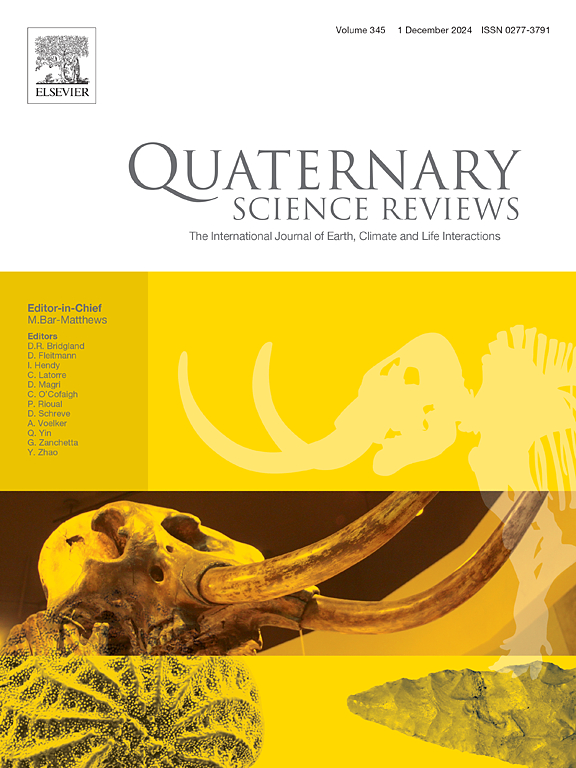Ecological environment of early-mid Holocene millet cultivation in northern China: Insights from the Xinglong site
IF 3.2
1区 地球科学
Q1 GEOGRAPHY, PHYSICAL
引用次数: 0
Abstract
The Xinglong site in Bashang Grassland has yielded crucial archaeological materials from the Paleolithic-Neolithic transition to mid-Neolithic period, including early-mid Holocene settlement and millet remains, providing critical insights into prehistoric human-environment interactions. This study analyzes pollen and phytolith data from the TG1E profile, revealing three distinct climatic stages following the Younger Dryas: 1) a moderately warm-humid phase with intermittent aridity during the Holocene onset (11,700–10,000 cal. a BP); 2) sustained warm-humid conditions in the early-mid Holocene (10,000–5000 cal. a BP); and 3) an progressive cool-arid phase during the mid-late Holocene (since 5000 cal. a BP). Vegetation transitioned from steppe to forest-steppe and subsequently to sparse wood grassland. The early-mid Holocene (ca. 10,000–7100 cal. a BP) presented optimal environmental conditions, though woody plant fluctuations suggest anthropogenic impacts of wood consumption from sedentism and ecological impacts of proto-agricultural practices in low-level food production system. Hydrological evidence indicates intermittent wetland presence near the site during 11,700–1800 cal. a BP, with significant water-level variability. Settlement patterns reveal strategic occupation of northwest hill-southeast aquatic basin micro-landscape, with millet cultivation emerging as a subsistence supplement to hunting-gathering by at least 8600 cal. a BP. Further multi-proxy analyses are required to elucidate environmental-cultural dynamics during this period.
全新世早期至中期中国北方谷子种植的生态环境:来自兴隆遗址的启示
坝上草原兴隆遗址出土了从旧石器时代-新石器时代过渡到新石器时代中期的重要考古材料,包括全新世早期-中期的定居点和谷子遗迹,为史前人类与环境的相互作用提供了重要的见解。本研究分析了来自TG1E剖面的花粉和植物岩数据,揭示了新仙女木期之后的三个不同的气候阶段:1)全新世开始(11,700-10,000 cal. a BP)的中度温暖湿润阶段,间歇性干旱;2)全新世早中期(10000 ~ 5000 cal. a BP)持续的暖湿环境;3)全新世中晚期(5000 cal. a BP以来)的一个递进的冷-干旱阶段。植被由草原向森林草原过渡,继而向疏林草地过渡。全新世早中期(约10,000-7100 cal. a BP)出现了最佳环境条件,但木本植物的波动表明,人类对定居生活中木材消耗的影响以及低水平粮食生产系统中原始农业实践的生态影响。水文证据表明,在11,700-1800 cal. a BP期间,遗址附近存在间歇性湿地,具有显著的水位变化。聚落模式揭示了西北丘陵-东南水生盆地微景观的战略占领,小米种植至少在8600 cala BP出现,作为狩猎采集的生存补充。需要进一步的多代理分析来阐明这一时期的环境文化动态。
本文章由计算机程序翻译,如有差异,请以英文原文为准。
求助全文
约1分钟内获得全文
求助全文
来源期刊

Quaternary Science Reviews
地学-地球科学综合
CiteScore
7.50
自引率
15.00%
发文量
388
审稿时长
3 months
期刊介绍:
Quaternary Science Reviews caters for all aspects of Quaternary science, and includes, for example, geology, geomorphology, geography, archaeology, soil science, palaeobotany, palaeontology, palaeoclimatology and the full range of applicable dating methods. The dividing line between what constitutes the review paper and one which contains new original data is not easy to establish, so QSR also publishes papers with new data especially if these perform a review function. All the Quaternary sciences are changing rapidly and subject to re-evaluation as the pace of discovery quickens; thus the diverse but comprehensive role of Quaternary Science Reviews keeps readers abreast of the wider issues relating to new developments in the field.
 求助内容:
求助内容: 应助结果提醒方式:
应助结果提醒方式:


